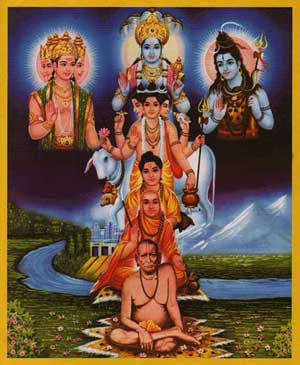Swami Samarth
Akkalkot Niwasi Shri Swami Samartha also known as Swami Samartha Maharaj, Swami Maharaj is a household name in Maharashtra, Karnataka and Andhra Pradesh.
Swami Samartha of Akkalkot is considered by many to be the very form of Shri Nrusimha Saraswati of Ganagapur. Occasionally, Swamy said that he was Nrusimha Bhan and the he was from kardalivan near Srisailam confirmed that he was Nrusimha Saraswati. Swamy took up numerous names at different places which made it hard to trace his travels. He died in 1878.
The reality is that Swami Samarth and Shri Shirdi Sai Baba were the manifestations of the same Divine Spirit in two gross bodies.
Dattatreya incarnation of the Divine Trinity Brahma, Vishnu and Siva and his avatars- Shripad Shri Vallabha, Sri Nrusimha Saraswati and Swami Samartha Maharaj.
As per “Shripad Shrivallabha Charitra” Guru Dattatreya took 3 Avatars: Shripad Shri Vallabh, Sri Nrusimha Saraswati and akkalkot Swami Samaratha Maharaj.
Shri Swami Samartha comes from the age-old guru tradition of the Dattatreya sampradaya. The main chanting mantra of this tradition is
Digambara Digambara Shripad Vallabh Digambara
Shri Swami Samartha is believed to be the incarnation of Shri Narasimha Saraswati who in turn is the believed incarnation of Shri Shripad shriVallabha. Although not much is known about Shri Shripad Shrivallabh, the life story of Shri Narasimha Saraswati is well documented. “Shripad Shrivallabh Charitamrut” (the book describing the life story of Shri shripad Shrivallabh) has been recently publicized.
The biography of Shripad Shrivallabh in “Shripad Shrivallabh Charitra”.
The biography of Shrimad Nrusimha Saraswati in “Shreemad Gurucharitra”.
Shreemad gurucharitra gives us the details of his work in guiding the devotees and the various miracles he performed to help devotees. He stayed at Gangapur (Karnataka State, Southern India) for a long time and then gave his “Nirguna Padukas” to his disciples and devotees, before leaving for he kardali forests to perform Tapas [penance]. My swami is samartha is best
EARLY LIFE OF SWAMI MAHARAJ
Shri Narasimha Sarawati about four centuries before the advent of Swami Samartha is believed to be the earlier incarnation of Shri Dattatreya. The ‘Guru Charitra’ one of the most famous books gives lot of information about him. As per the most popular belief, shri Narasimha Swami, after helping and spiritually uplifting a large number of people over a few decades, went away o the Kardali vana for penance and went into Samadhi. In the Samadhi state he remained for about three hundred years. With the passage of time a huge anthill grew over him and he was lost to the outside world. One day accidently a woodcutter’s axe fell on the bushes grown around the ant hill. He was shocked to see blood stains on the blade of the axe. He cleared the ant hill and he found a Yogi meditating. The yogi slowly opened his eyes and consoled the dumbfounded woodcutter saying that it was the divine Will for him to re-appear in the world to resume his mission. This Yogi, in his new role came to be known as Swami Samartha.
In other accounts, shri Narasimha Swami was staed to retreat ‘in the Kardali Wilderness’. Whereas Swami Samartha purportedly has stated that he ‘came from the Kardali Wilderness’, after which he roamed about in China, Tibet, Nepal and Northern India, before setting down in Akkalkot.
Prior to his settlement at akkalkot, Swami Samartha

seems to have visited far and wide. While moving in the Himalayan region he visited places like Puri, Banaras, Hardwar, Ginnar, Kathiawad and Rameshwaram in the South. He also stayed at Mangalvedha, a town near Pandharpur in Solapur district Maharashtra, which had been inhabited earlier by famous saints like Domojipant and Chokhamela. He came to Akkalkot in 1856 where he continued his physical existence for 22 years. He came to Akkalkot on the invitation of one Chintopant Tol and stayed at a place on the outskirts of the town.

seems to have visited far and wide. While moving in the Himalayan region he visited places like Puri, Banaras, Hardwar, Ginnar, Kathiawad and Rameshwaram in the South. He also stayed at Mangalvedha, a town near Pandharpur in Solapur district Maharashtra, which had been inhabited earlier by famous saints like Domojipant and Chokhamela. He came to Akkalkot in 1856 where he continued his physical existence for 22 years. He came to Akkalkot on the invitation of one Chintopant Tol and stayed at a place on the outskirts of the town.


No comments:
Post a Comment